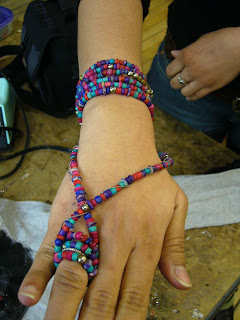itp.nyu.edu/~rjs425/Yaad.ppt

Above, is the representation of the malenge of technology and traditional artwork
below shown are the conductive threads extensions that connected to the conductive fabric to complete the circuit.
Yaad, my blouse is hand embroidered by me and is a part of a very traditional exercise of creating things for one’s trousseau. It brings out the Rabari Tribal handwork from a place where color is synonymous to life- the states of Gujarat and Rajasthan in India.
The garment is a fascinating patchwork, with a glistening array of floral patterns a fascinating patchwork composition that is sewn by hand and embroidered with shiny sequins and beads. The cloth is first soaked in salt water for a day and then dried in the sun. The patterns are then traced out onto the cloth and spaced out keeping in mind the required space for the stitching. The embroidery is usually a collage of different patterns such that the based cloth is never visible. I selected to keep it simple and tried not to make it flashy as it is usually the case. I chose floral patterns with a row of peacocks. Usually most animal or animate figures come at the base of the garment while the lighter elements are arranged or dispersed all over the garment. The colors used are bright, joyous and seemingly random and an elegant fusion of magenta, red green and blue hues is maintained so that the garment is not just a piece of art but instead a blouse that can be worn occasionally. To differentiate from the traditional blouse, I have completely left out the use of mirrors and have sparingly used sequins. Mirrors are usually used to reflect off evil spirits. The light reflected would bring out the color of the thread used by reflecting light off them. To this traditional piece I wanted to add my touch of technology without really destroying its traditional appeal. In place of the mirrors, I used LEDs to do the same purpose.
The garment is a fascinating patchwork, with a glistening array of floral patterns a fascinating patchwork composition that is sewn by hand and embroidered with shiny sequins and beads. The cloth is first soaked in salt water for a day and then dried in the sun. The patterns are then traced out onto the cloth and spaced out keeping in mind the required space for the stitching. The embroidery is usually a collage of different patterns such that the based cloth is never visible. I selected to keep it simple and tried not to make it flashy as it is usually the case. I chose floral patterns with a row of peacocks. Usually most animal or animate figures come at the base of the garment while the lighter elements are arranged or dispersed all over the garment. The colors used are bright, joyous and seemingly random and an elegant fusion of magenta, red green and blue hues is maintained so that the garment is not just a piece of art but instead a blouse that can be worn occasionally. To differentiate from the traditional blouse, I have completely left out the use of mirrors and have sparingly used sequins. Mirrors are usually used to reflect off evil spirits. The light reflected would bring out the color of the thread used by reflecting light off them. To this traditional piece I wanted to add my touch of technology without really destroying its traditional appeal. In place of the mirrors, I used LEDs to do the same purpose.


Introduction:
Traditional art and crafts have always intrigued me and having talked to creators of this type of art work and my personal experiences with working in traditional art forms, I have observed that most of these art forms have their patterns inspired from nature and its elements. Whether it’s the making of a garment or art work that uses natural dies or the design patterns that are usually prints of birds, animals and plants; every single element is an expression derived from the environment around them. Using this as a basis, I wanted to create a garment that would be a traditional work of embroidery with inherent presence of technology in it.





